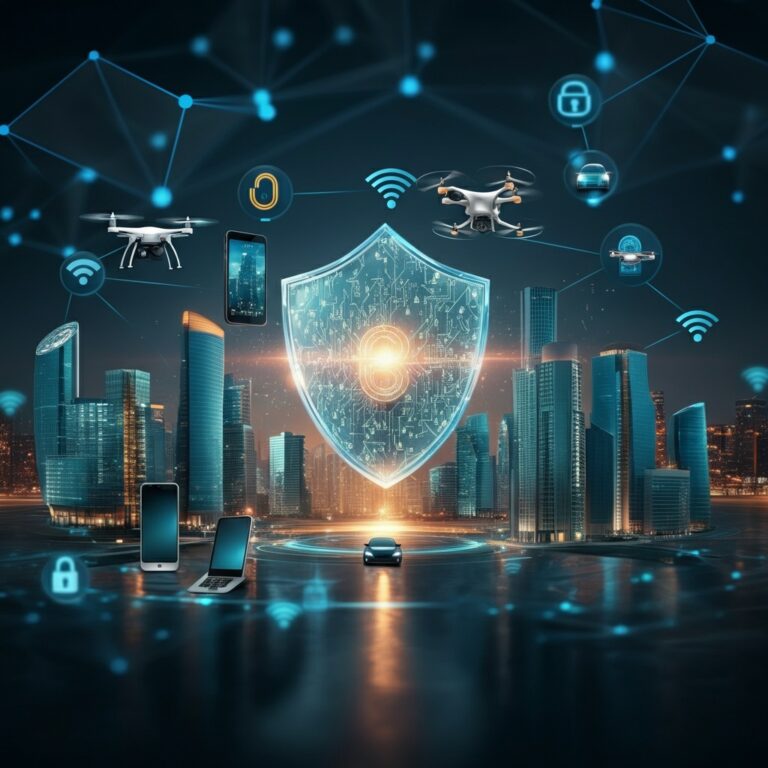IoT Blockchain security solutions are essential. Imagine a future in which each gadget—your smart refrigerator, fitness tracker, and linked car—fits into a complex communication network. The Internet of Things (IoT) makes this a reality.
But along with this fantastic ease comes a frightening reality: security hazards.
IoT devices have opened fresh risks as hackers use weak points in these networks to pilfer data, disturb operations, or even take over essential systems. Conventional security approaches have failed to keep pace, endangering companies and people.
This is when blockchain technology becomes revolutionary. With its distributed design, unchangeable record-keeping, and innovative contract capabilities, blockchain offers unique answers to IoT’s expanding security concerns.
This blog will discuss the present situation of IoT security, how blockchain increases IoT defences, critical solutions currently in use, and a look at the future of this exciting junction of technology.
Challenges in IoT Blockchain Security
IoT devices are accelerating, with an expected 14.4 billion linked devices globally in 2023. That count is predicted to rise to 41.6 billion by 2025. These gadgets gather enormous volumes of sensitive information from industrial sensors to house automation systems. However, this fast acceptance has exceeded the evolution of sufficient security protocols.
Typical Security Vulnerabilities
For IoT Blockchain Security, the IoT devices are particularly susceptible because many depend on easily used default passwords that might be weak.
Unencrypted Communication: Data sent between devices in plaintext is often easily available to attackers. Manufacturers often neglect to provide firmware upgrades to fix flaws.
IoT Security Breaches: Their Costs
Cyberattacks targeting IoT devices may cause significant financial and reputational damages. For example, the well-known Mirai botnet assault employed weak IoT devices and resulted in extensive internet failures. Such breaches are costly; IoT-related hacks are expected to cost $15.8 billion yearly by 2023.
Modern Restraints of IoT Security
Conventional security solutions like centralised firewalls and antivirus software cannot adequately control the dispersed character of IoT. These one-point failures give attackers more chances. One absolutely needs a fresh strategy.
How Does Blockchain Improve IoT Security?
Blockchain‘s core features make it a perfect fit for fixing IoT security issues. Its capacity for auditing, authenticating, and decentralising data has excellent benefits.

Significant Blockchain Advantages for IoT
Decentralized Architecture
IoT Blockchain Security. The Blockchain operates on a distributed ledger, eliminating single points of failure. This dispersed architecture makes network compromise more difficult for hackers.
Undoubtedly Notes
Blockchain-recorded transactions cannot be changed. This guarantees a safe, tamper-proof record for all data exchange between IoT devices.
Smart Contracts: Blockchain lets one employ self-executing contracts that streamline IoT activities. For instance, a smart thermostat may change room temperature without intervention while preserving safe data integrity.
Access Control and Verification
Blockchain allows devices to confirm their identities, guaranteeing only authorized units interact within the network.
Transparency of Data
Every data packet in a blockchain may carry a digital signature verifying it hasn’t been altered in route.
Critical Blockchain Solutions for IoT
Innovative security mechanisms resulting from blockchain integration into IoT networks are already there. The following are some powerful fixes:
Identity Management of Devices
Blockchain gives IoT devices their original digital identities. Devices may authenticate themselves within the network, guaranteeing safe interactions. VeChain, for instance, utilizes blockchain to confirm supply chain product authenticity, guaranteeing IoT sensors monitor actual products.
Safe Firmware Changes
Blockchain can securely provide firmware upgrades. Using distributed ledgers allows manufacturers to guarantee that devices get real updates free from manipulation. Ethereum-based platforms are already testing this option for critical systems.
Information Control of Access
Blockchain lets IoT devices have fine-grained access control. Smart contracts allow companies to define certain rights for individuals and devices, improving operational security.
Automated Policies for Security
Device authentication and threat detection are among the tasks smart contracts enable to automate. A smart contract may, for example, automatically prohibit access and notify managers should an illegal device try to join the network.
Instantaneous Threat Detection
Blockchain-based systems’ real-time threat detection and response capability allows cybersecurity firms such as Guardtime to monitor IoT networks for abnormalities, generating quick notifications and fixes.
Challenges for Implementation and Solutions
Blockchain greatly enhances IoT security, yet there are challenges to get past:
Resources Restricted
Blockchain systems are challenging to use on IoT devices due to their limited processing capacity and storage. However, by means of data processing optimization, lightweight blockchain systems like IoT-BT (Internet of Things Blockchain Technology) overcome these limitations.
Problems with scale
Data volume rises along with IoT networks’ expansion. Scalability is still an issue as conventional blockchains like Bitcoin can only process a small amount of transactions per second. More effective blockchains, like Solana, and Layer 2 solutions provide interesting scalability without sacrificing security.
Complications of Integration
Including blockchain in current IoT systems might be challenging. Middleware solutions like IOTA, however, seek to close the gap and streamline corporate onboarding.
Useful Solutions
Industry alliances like IBM’s one with Samsung on ADEPT (Autonomous Decentralized Peer-to-Peer Telemetry) highlight how pooled knowledge may help to overcome obstacles in blockchain implementation and scalability for the Internet of Things.
Outlook for Future Events
IoT and blockchain convergence will only become more pronounced in the next years. One of the new trends is IoT security enhanced by artificial intelligence using blockchain technologies for proactive threat detection.
Decentralised IoT platforms allow devices to communicate with peers.
Increasing industry use is shown by recent pilot projects in smart cities, healthcare, and logistics.
Guard Your IoT The blockchain of the future is transforming IoT security strategy. It provides automated, distributed, tamper-proof solutions to cover weaknesses in contemporary IoT systems. Blockchain allows companies to guard their data, boost network trust, and open fresh prospects.
Early Use: Organisations wishing to investigate blockchain-based IoT security solutions have time to act. Early use of these technologies will help protect your operations and prepare for a linked safe future. Let blockchain be your friend in keeping the Internet of Things secure.
Thus, we should continue investigating, inventing, and stretching the possibilities of using IoT and blockchain.
These two technologies can cooperate almost endlessly; we must maximise their potential and build a safer digital environment for everyone.
Data integrity, privacy, and security will not be the main issues as more sectors embrace IoT and blockchain. Together, they will open the path for better consumer experiences, more effective supply networks, and smarter cities.
Obstacles: However, like any developing technology, there will always be obstacles. Organisations must prioritise security and keep current with the most recent developments in IoT and blockchain technologies.
Businesses may overcome challenges and best use these breakthroughs by encouraging a culture of lifelong learning and teamwork. Governments, technology businesses, and academic institutions must also cooperate to establish firm rules and frameworks supporting scalable IoT-blockchain connections.
The next few years will undoubtedly offer innovations that will further unite IoT and blockchain capacities. Modern artificial intelligence and quantum computing will probably complement existing systems, promoting even more creativity and efficiency.
Companies that are flexible and ready to test new technologies will lead the way in transforming sectors and tackling some of the digital era’s most urgent issues.
Conclusion
Though IoT and blockchain have bright futures, their success will rely on cooperation, information exchange, and a shared dedication to security and performance. The secret to revolutionizing our way of life and business in a world becoming increasingly digital is this cooperation between many innovative technologies. The opportunities are amazing; the opportunity to help build this future is right now.
Research and development investments allow companies to find creative solutions for the complexity of IoT and blockchain integration. For devices with limited resources, for example, creating more energy-efficient consensus algorithms or better cryptographic techniques would maximize performance.
Moreover, encouraging cooperation between the public and commercial sectors helps hasten practical implementations and promotes general acceptance in many different areas.
Education and awareness are also essential in this changing terrain. Businesses must equip their staff to grasp the complexities of IoT and blockchain technologies and their joint uses.




